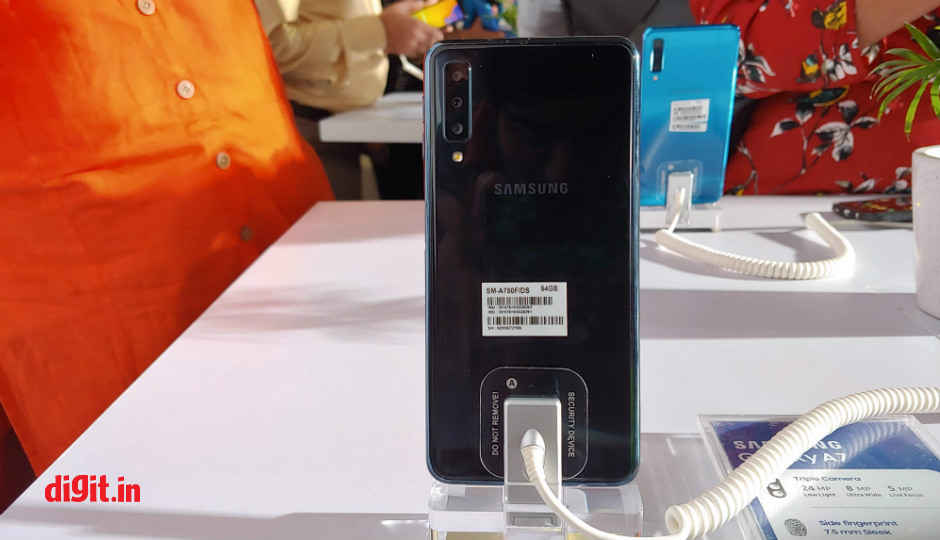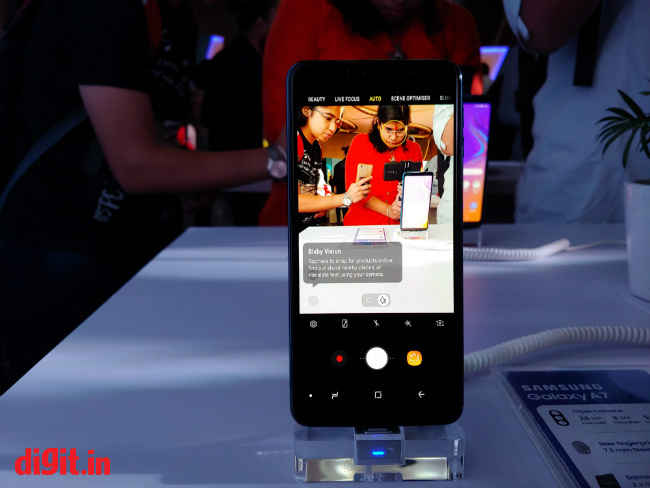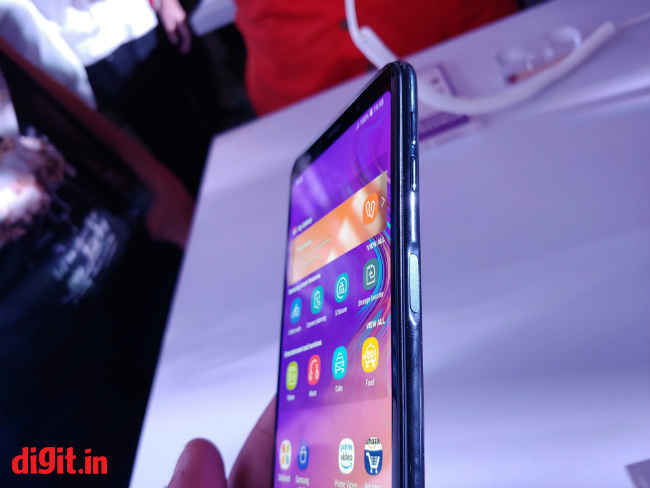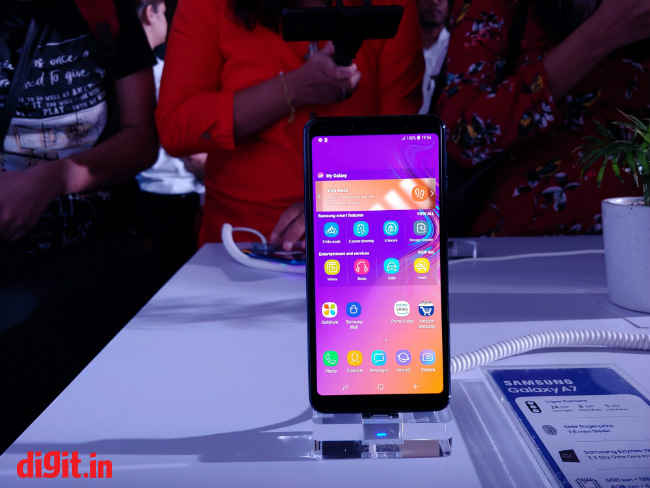Samsung Galaxy A7 First Impressions: A three-eyed beauty on a budget

The Samsung Galaxy A7 marks a strategic shift in the way Samsung innovates in its mobile lineup. Instead of a flagship, it's the mid-range Galaxy A7 that introduces Samsung fans to a triple-camera setup.
The Samsung Galaxy A7 that launched today in India marks a drastic change in Samsung’s strategy for the Indian market. Over the years, Samsung’s mid-range phones have always borrowed from its more expensive siblings. Samsung didn’t use the A-series to show off new innovations. All that changed in the Galaxy A7 when Samsung made it the platform to launch a triple-camera setup on the back. Along with three cameras, the Galaxy A7 is also the first crop of Samsung devices to feature the fingerprint sensor embedded in the power button. Also, there’s a new design that takes after Huawei’s innovations in glass designs.
In a lot of ways, the Samsung Galaxy A7 marks the beginning of a new era in Samsung’s mobile division. The focus is not solely on the flagship chipsets anymore. I presume Samsung has learnt it the hard way that ignoring the budget and mid-range lineup, especially in a market as competitive as India, will create opportunities for rivals. The attempt at course correction comes in the form of the Samsung Galaxy A7 and it’s shaping up to be a good challenger to the likes of Asus Zenfone 5z and the Poco F1.
Triple camera setup — A first for Samsung
The Galaxy A7 features three cameras on the back. A 24MP sensor with an f/1.7 aperture lens for your regular shots. An 8MP sensor with a 13mm ultra-wide lens with f/2.4 aperture and a 5MP sensor with fixed focal length and f/2.2 aperture to capture depth of field. It’s certainly interesting that Samsung now wants to provide all sorts of options to the budding smartphone photographer. We haven’t tested the camera fully to give you a definitive verdict. Stay tuned for the in-depth review for that. However, it needs to be noted that the Galaxy A7 is essentially doing the same thing the Asus Zenfone 5z does with two cameras. The Zenfone 5z also features a 12mm wide-angle lens for sweeping, wide shots. The primary 12MP sensor on the Zenfone 5z also takes portrait shots using machine learning algorithms.
The Galaxy A7’s camera also has in-built scene recognition features and offers depth of field control in post-production. You can control the amount of bokeh and also the type of bokeh after you’ve taken the photo. You can also cycle between different kinds of light effects in the portrait mode, giving you a similar experience as the new iPhones.
Up front is a 24MP sensor with f/2.0 aperture for selfies. Here, the portrait mode is processed through a single camera unit using complex algorithms.
A new home for the fingerprint sensor
The Samsung Galaxy A7 along with the Galaxy J6+ and the Galaxy J4+ are the first Samsung phones to feature the fingerprint sensor embedded in the power button on the side. At the launch, Samsung claimed users usually press the power button first and then unlock the phone using a rear-mounted fingerprint sensor. Although, in all these years of reviewing a phone, I don’t remember following this two-step process. Usually, scanning your finger directly unlocks the phone and the power button is only used to either lock the phone or to check information on the lock screen.
The Samsung Galaxy A7 also features a new glass finish. The mid-range phone comes in three new colours — Blue, black and gold. All the three variants have a shiny finish where light reflects off the surface to create different streaks. Furthermore, the Galaxy A7 feels quite lightweight, and has a slim profile that doesn’t make it unwieldy by any means.
A 6-inch Super AMOLED display
Samsung makes the best displays in town and the Galaxy A7 also comes featuring the Super AMOLED panel that makes Samsung phones so immersive. The A7 sports a 6-inch Infinity Display with 18.5:9 aspect ratio. The company is still holding out against the notch and there hasn’t been a Samsung phone fitted with that ugly invention. As a result, this isn’t one of your ‘bezel-less’ phones. There are significant bezels both on top and the bottom of the display and thin lines along the edges.
Mid-range phone = Mid-range performance
The Galaxy A7 is powered by the octa-core Exynos 7885 SoC clocked at 2.0GHz. It’s relatively underpowered if you compare it against other flagships like the Zenfone 5z and the Poco F1, both of which are powered by the flagship Snapdragon 845. The mid-range chipset is based on a 14nm manufacturing is actually the first 7-series Exynos chipset to feature Cortex-A73 cores and support for Bluetooth 5.0. Earlier, the Exynos 7880 that powered the Galaxy A7 (2017) and the Galaxy A8 (2017) was made of low-power Cortex-A53 cores. I’m hoping for a big jump in performance on the basis of the new microarchitecture. The chipset is paired with either 4GB or 6GB of RAM and 64GB of onboard storage. Samsung augments the storage space by allowing users to install apps in the microSD card, a feature that could be enabled after granting root access to Android phones. It’s now an official feature, but it’s likely going to slow the phone down if you’re using a memory card with slow read/write speeds. The phone runs on the latest Android 8.1 Oreo OS with Samsung’s Experience UI on top. Powering the whole thing is a 3,300mAh battery.
First Impressions
The Samsung Galaxy A7 is one surely one of the most exciting mid-range Samsung phone in a while. The inclusion of a triple-camera unit and a new design along Samsung’s robust UI design is something quite attractive. Even more attractive is the price of the phone. The Galaxy A7 is priced at Rs 28,990 for the 6GB RAM variant while the 4GB RAM variant is priced at Rs 24,990. That puts the phone directly in the leagues of the Nokia 7 Plus (review), Poco F1 (review) and the Asus Zenfone 5z (review).







